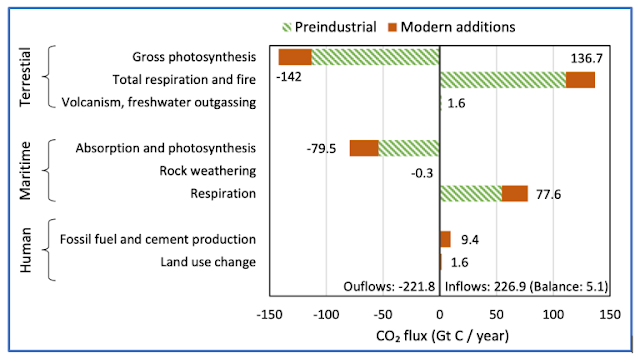Is Temperature Causing the Increase in CO2?
Every once in a while a paper gets published in a low-to-no impact journal suggesting that the increase in CO2 concentrations was caused by the increase in global temperatures and not by human emissions. There are several blogs and unpublished manuscripts that make similar claims. Now for sure, since CO2 is less soluble in warmer water, increasing sea surface temperatures, so increasing temperature does cause an ocean-to-atmosphere CO2 flux. But can this explain why CO2 levels are increasing? Some say yes. The most recent paper[1] was published in a no-name MDPI journal called Sci, and Judith Curry promoted it on her blog.
Papers and arguments like this are obviously nonsense, but this paper is a little unique in that it includes the very evidence that proves its central thesis wrong. The following chart comes from the paper. It takes data from the IPCC AR6 accounting of the carbon budget, showing the ocean, land and human sources and sinks. From the numbers the authors included in this graph, the land is a net carbon sink, and the oceans are a net carbon sink. Meanwhile human activity is responsible for a source of +11 GtC and a sink of -0 GtC. So if the increase in CO2 was caused by an increase in temperature and not from human emissions, where did the CO2 come from? Temperature can't create CO2; it has to come from somewhere, and land and oceans are both net carbon sinks so they can't be sources for the increase in CO2. This is pretty clear from the chart below from the very paper trying to argue the opposite.
The information from the above chart comes from figure 5.12 in AR6 below. It breaks down the various natural fluxes on land and ocean as well as anthropogenic fluxes from land use and fossil fuel use. The natural carbon cycle is a net sink. Natural sinks total -221.8 GtC/yr and natural sources total 216.8 GtC/yr, so without human sources, the natural carbon cycle would be a net sink of 5.9 GtC/yr. But since human emissions total 11 GtC/yr the carbon cycle is a net source of 5.1 GtC/yr. The data show that the oceans and land can't be the sources of atmospheric CO2.
So why do papers like this get written? When Curry posted about this paper on her blog, Demetris Koutsoyiannis, one of the authors, was responding to comments, and I had the opportunity to interact with him in the comment section. When I made the above point, he said something to me that I think explains why people get this so wrong:
I conjecture that the logic behind your arithmetic is this. A tree, before taking a molecule in its photosynthesis, first examines its origin, whether it was emitted by land or ocean or humans, and uses it only in the first case (and likewise for the ocean).
But I think there may be a better way to illustrate this without resorting to a financial analogy. We can think of carbon within the climate system as existing in three pools - the land, oceans and atmosphere - and carbon can be exchanged between these pools. Photosynthesis and respiration cause carbon to be exchanged between land and the atmosphere. Carbon exchanges between the oceans and atmosphere because of Henry's Law. The total amount of carbon in the climate system is roughly fixed, with two exceptions that occur naturally, volcanism and chemical weathering. Volcanism adds about 0.1 GtC/yr to the system, and the chemical weathering of rocks can remove as much as 0.3 GtC/yr, though that number may be a little too high. These natural additions and subtractions to the climate system are small, and they nearly offset, so I'm going to include them within the climate system for simplicity. On decadal and century time scales, the amount of natural carbon in the climate system is relatively fixed.
[1] Koutsoyiannis, D.; Onof, C.; Kundzewicz, Z.W.; Christofides, A. On Hens, Eggs, Temperatures and CO2: Causal Links in Earth’s Atmosphere. Sci 2023, 5, 35. https://doi.org/10.3390/sci5030035


.png)
.png)



Comments
Post a Comment